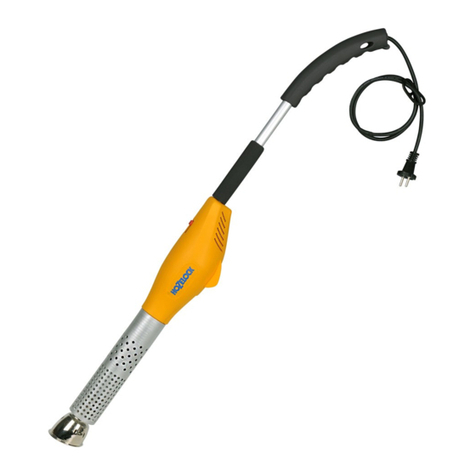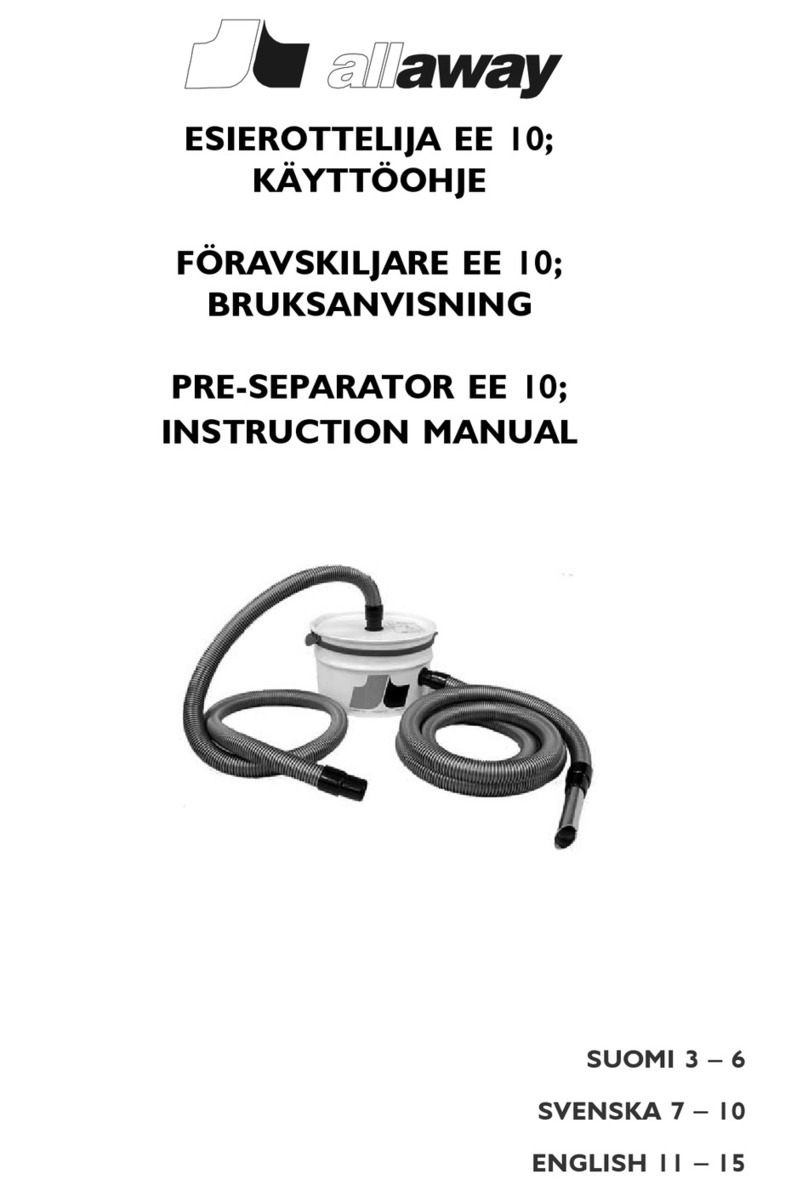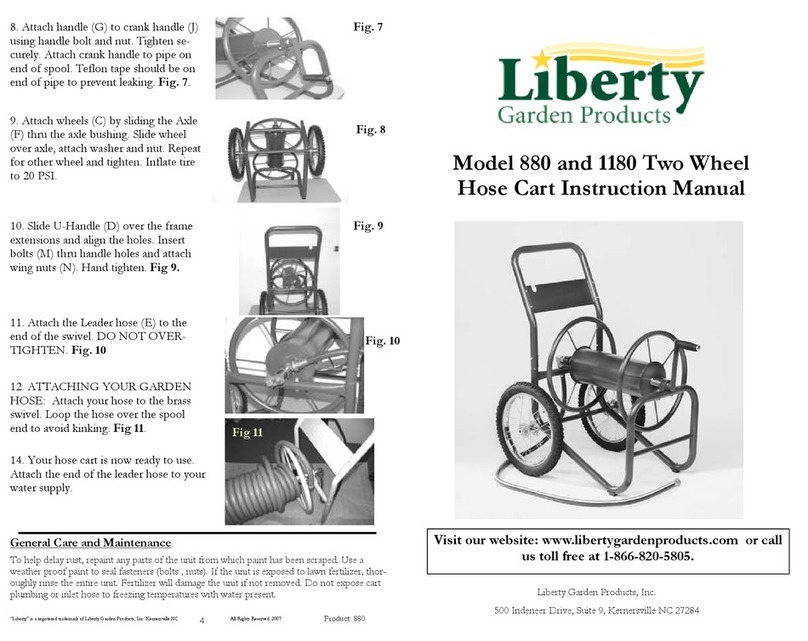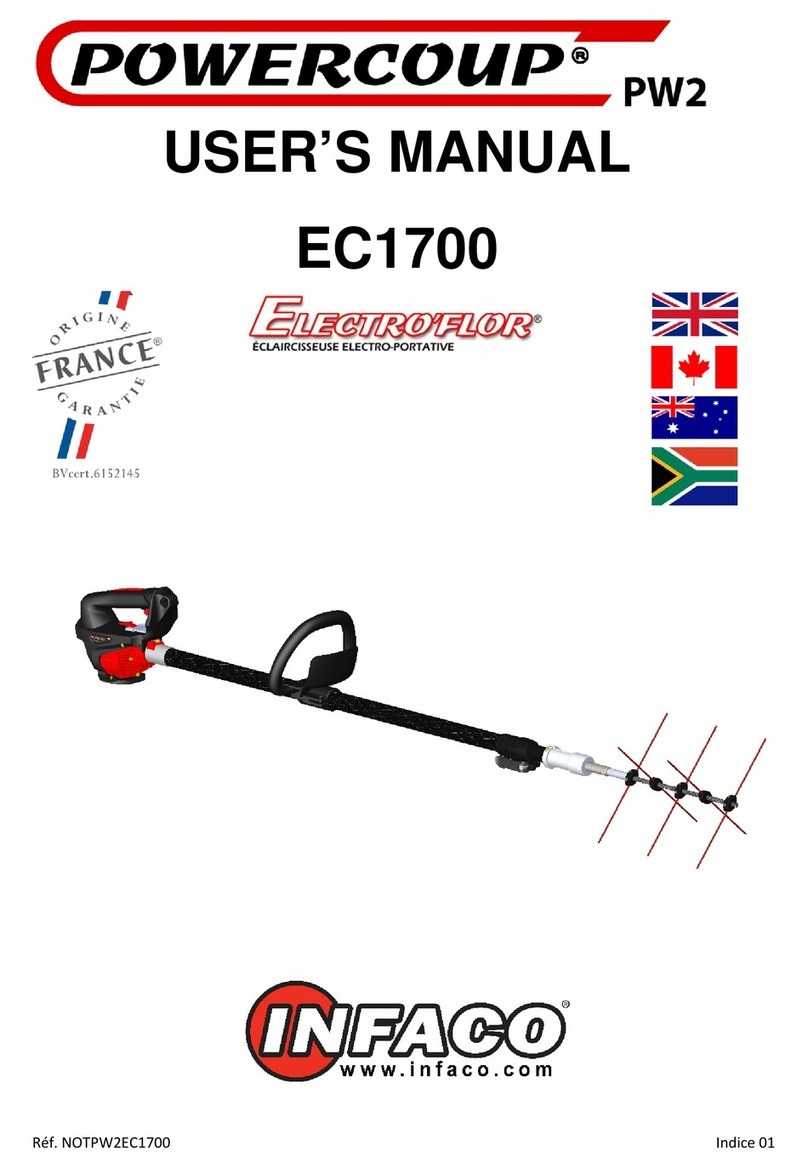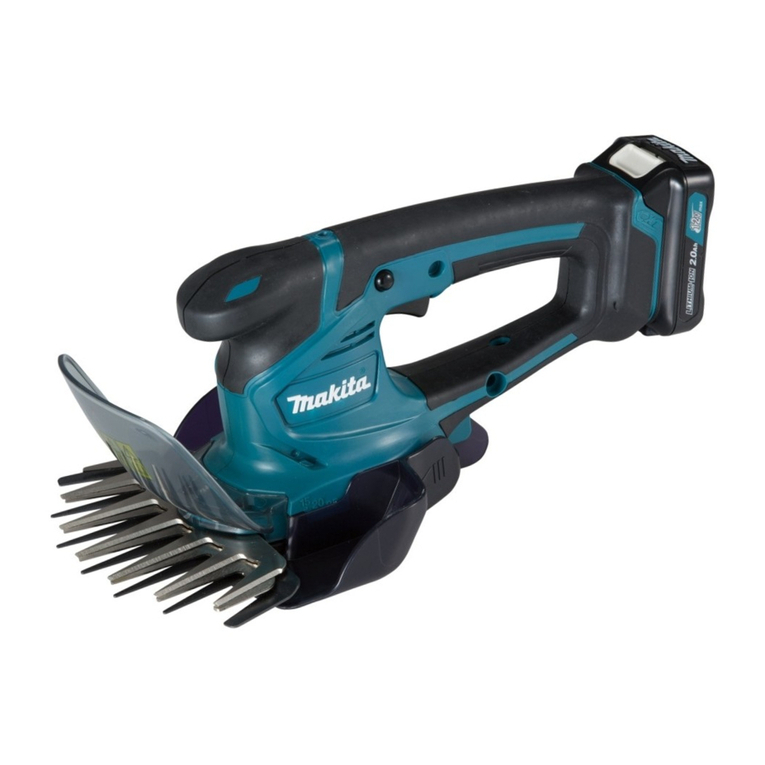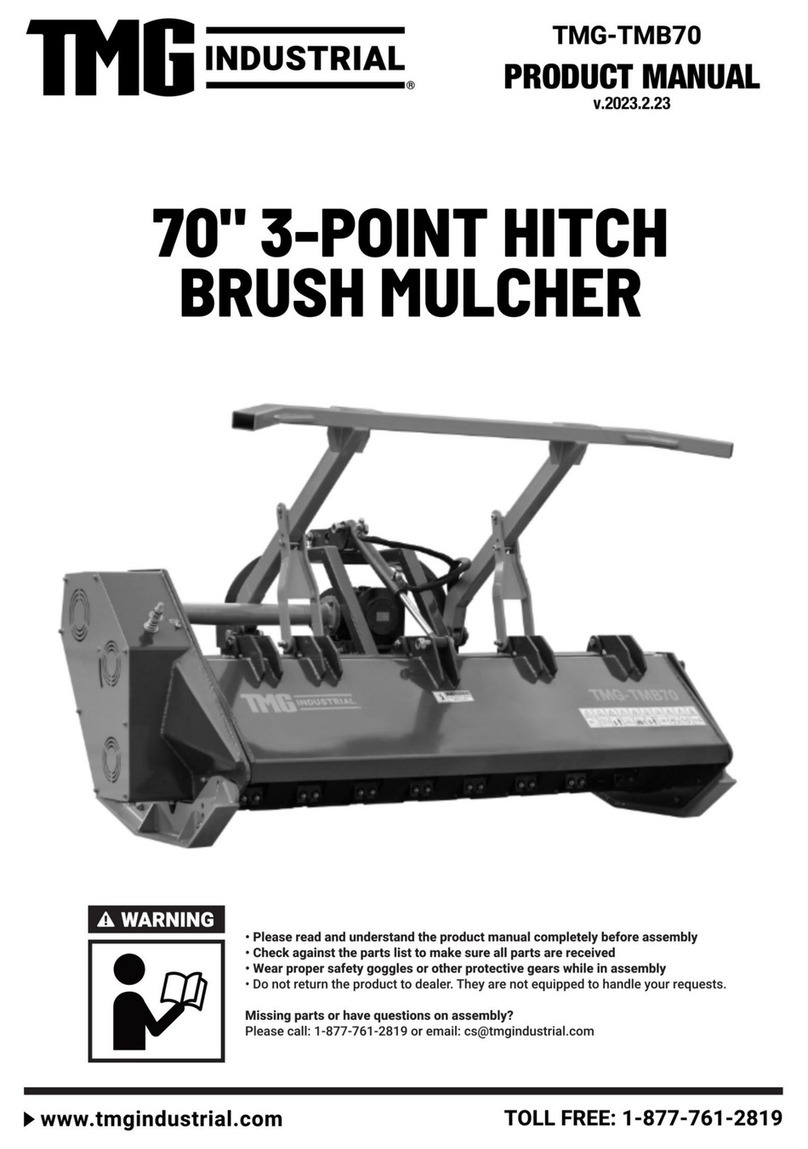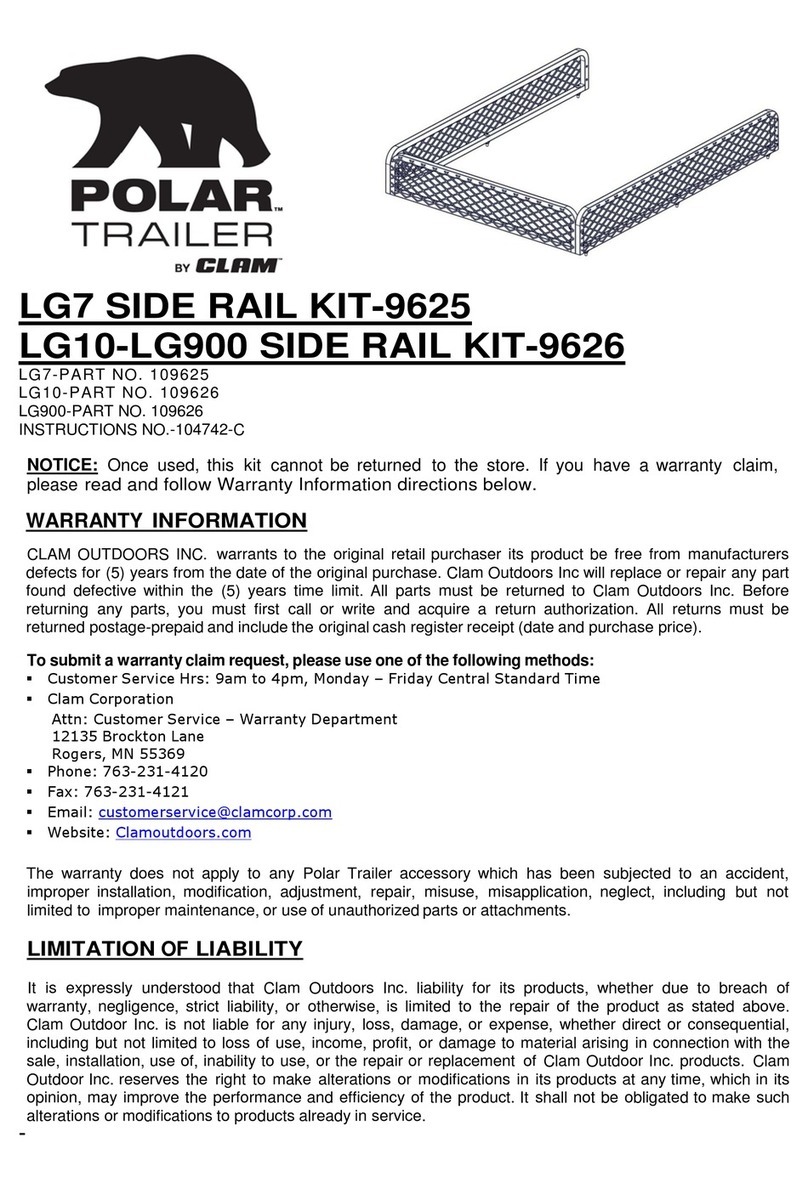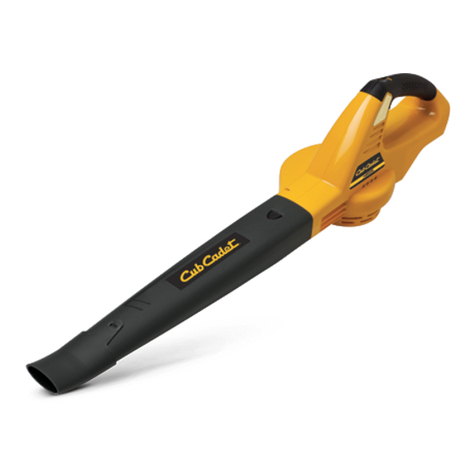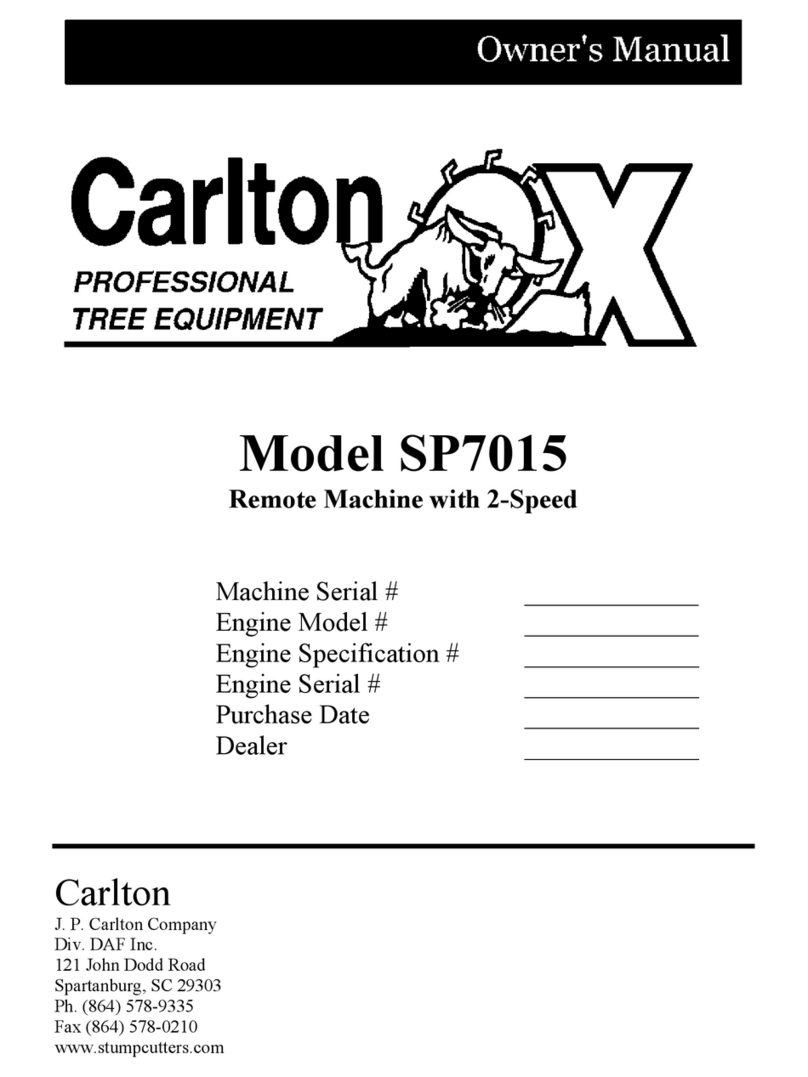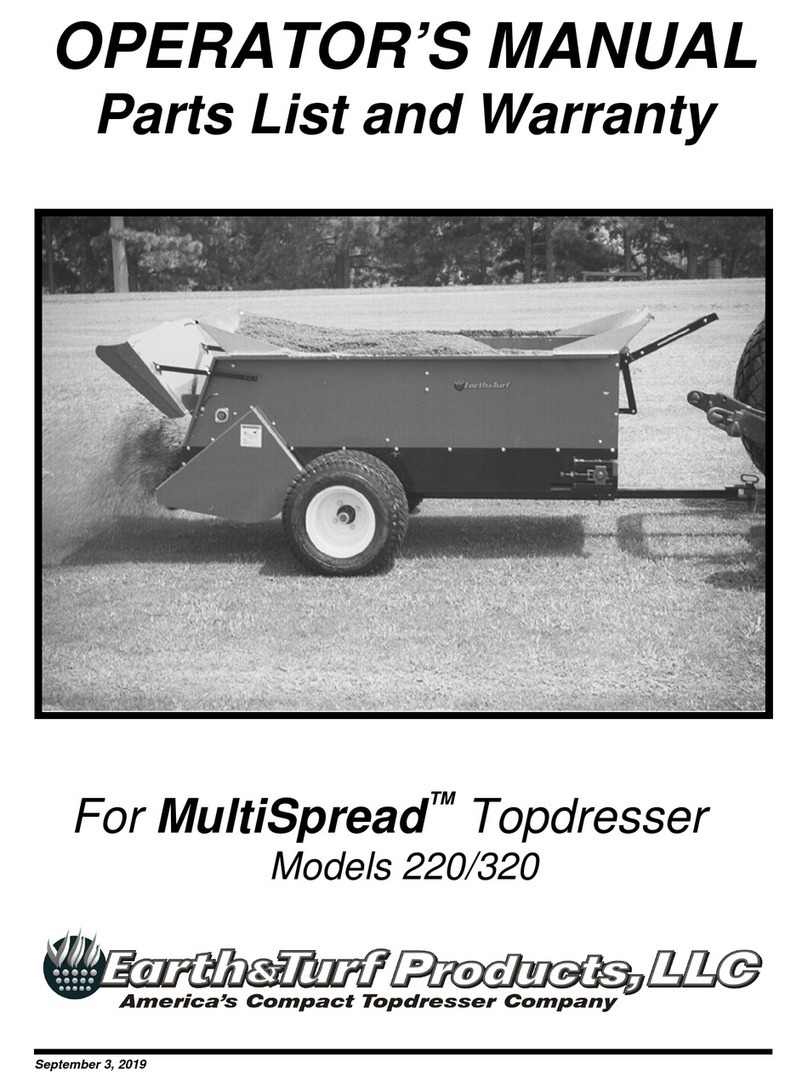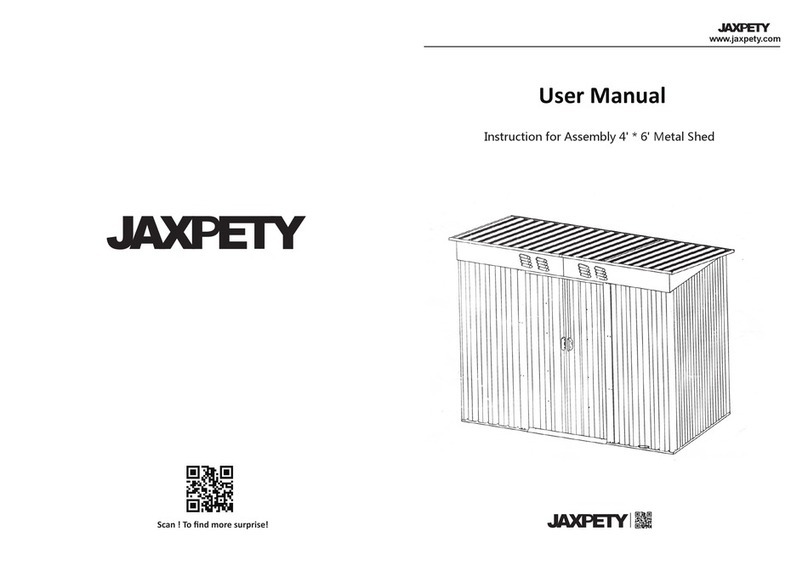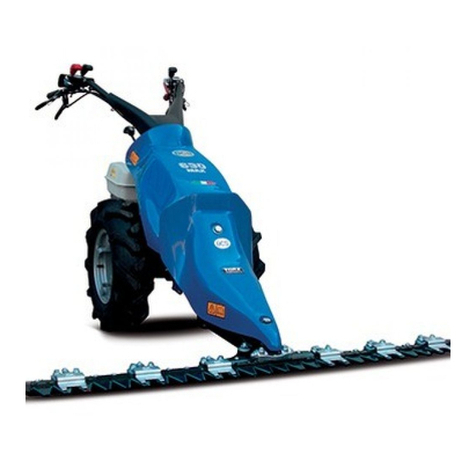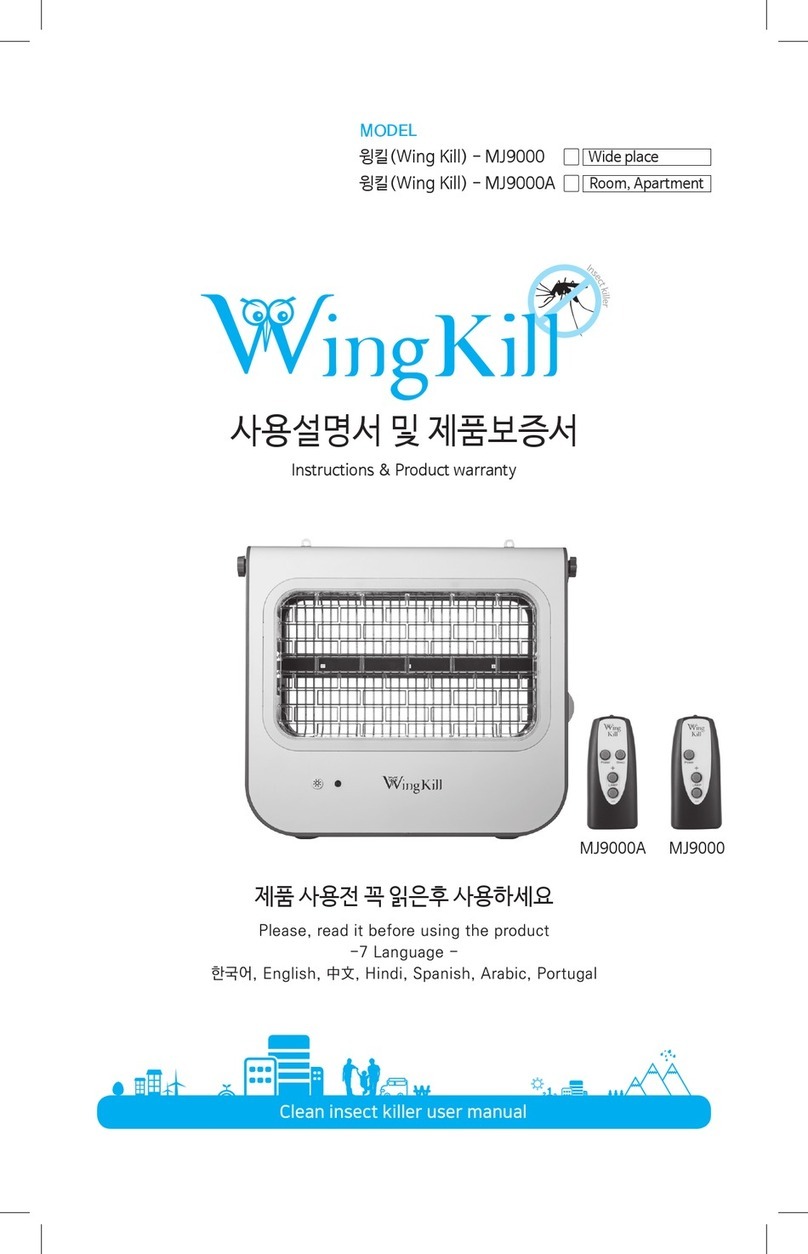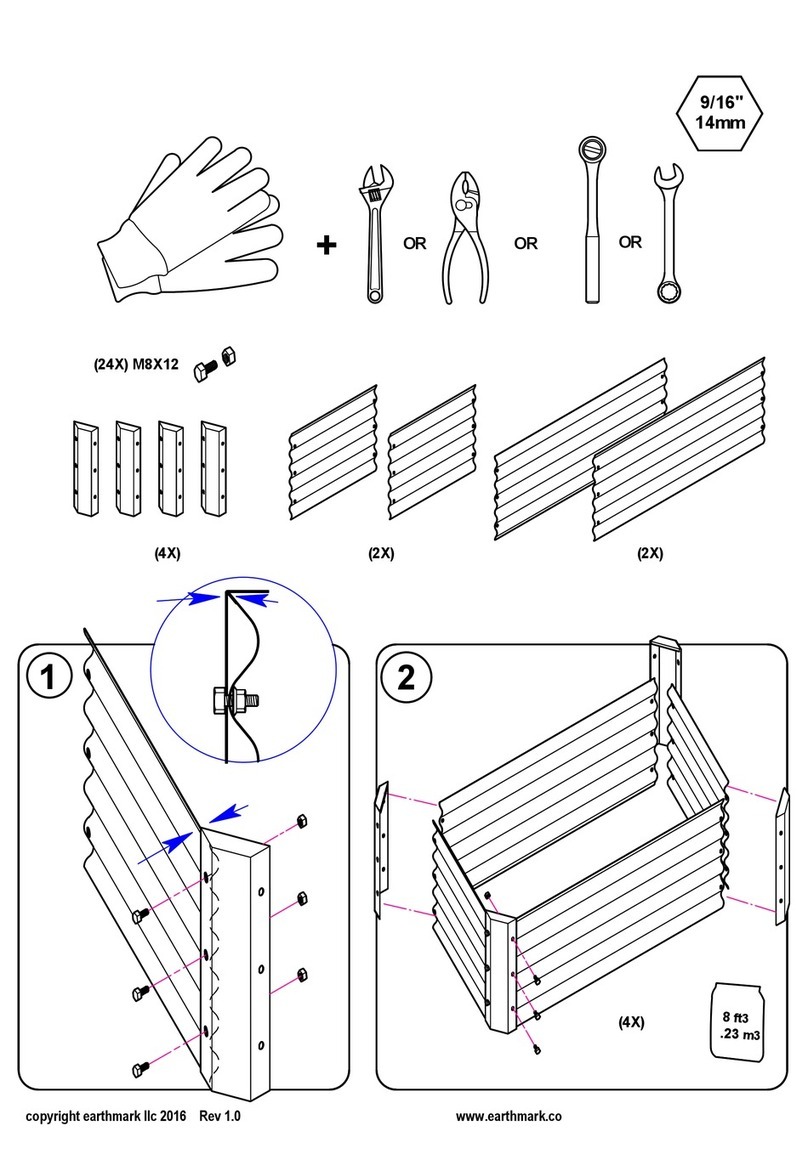BOXER BM 230 User manual

- 2 -
WARNING
READ MANUAL BEFORE OPERATING
DO NOT OPERATE OR PERFORM MAINTENANCE ON YOUR FORESTRY MULCHER WITHOUT READING AND
UNDERSTANDING THIS ENTIRE MANUAL FIRST.
IF THIS MANUAL IS LOST OR IF YOU HAVE ANY QUESTIONS, CONTACT US OR YOUR DEALER BEFORE YOU
PROCEED.
Understand the written instructions, rules and safety precautions:
The written instructions, rules and safety precautions are outlined in this operation and safety manual.
Check the rules and regulations at your location. The rules include employer’s work safety regulations and
local government guidelines and restrictions for safe operation of the equipment.
Perform application training with operator:
Conduct field instruction with a trained Operator. Application training should include complete vehicle
safety, operation training, complete mulching safety and application training.
Know and understand your work conditions; hazards should be reviewed and terrain surveyed at this time
as well as with all new work sites.
Verify that the machine is in complete safe working order and prepared for your application.

- 3 -
SAFETY
General
The Forestry Mulcher is designed to process heavy organic material such as branches, stumps, heavy timber
and brush.
Safety first
With any piece of equipment, new or used, the most important part of its operation is SAFETY! We encourage
you and your employees to familiarize yourselves with your new equipment and to STRESS SAFE OPERATION!
Prior To operation
Read the owner’s manual in its entirety and follow all safety procedures.
Check all grease points per the owner’s manual.
Inspect all fasteners for tightness with power off.
Manually turn rotor to inspect tool bolts with engine off.
Check gearbox oil (PTO models) for proper level per owner’s manual.

- 4 -
Forestry Mulcher – Description and Applications
Forestry
Orchard Removal
Land Clearing
Transfer Stations
Stump Grinding
ROW Maintenance
Yard Waste Process
Forest Fire Prevention
Brush and Slash Piles
The versatile Forestry Mulcher was designed for shredding woody materials. The Forestry Mulcher excels at
processing yard waste, land preparation and slash reduction. It has multiple uses for farmers, parks, golf
courses, loggers, land clearing companies, ranchers, foresters and Silva culturists.
The Forestry Mulcher shreds material into a fine particle size by going over the shredded material until the
desired texture is achieved. If left on the ground, the shredded material is beneficial to the soil. On steep slopes
the output from the mulcher is ideal for interim erosion control.
Operational Safety: The Work Area
For the sake of this manual, the front of the mulcher is the side with the rotor exposed. The rear has defection
chains. For crawlers and rubber tire machines, when the mulcher is mounted on the front of the machine, the
front of the mulcher is facing the same forward direction. If mounted on the rear, the front of the mulcher is
facing away from the rear of the carrier. Mounting for excavators and other boom-type installations may vary
but references to the front and rear of the mulcher remain the same.
Rear Access Panels
Rear
Side Inspection
Panels
Front
Side Access Panels
Rotor
Chains

- 5 -
The hazard zone
DANGER
FLYING DEBRIS OR OBJECTS AND FALLING OBJECTS CAN CAUSE SERIOUS INJURY OR DEATH
Improper operation and failure to follow safety precautions can cause serious injury or death. All personnel
must be clear of the hazard zone while the Mulcher is in operation.
The Hazard Zone is illustrated in Figure 1.1 on the following page. All personnel should be kept clear of this
zone while the mulcher is operating.
The shaded area in the Hazard Zone must be considered OFF LIMITS TO ALL INDIVIDUALS! The operator should
follow the PRECAUTIONS below before and during operation of the mulcher.
Hazard Zone Precautions
It is the OPERATORS RESPONSIBILTY to ensure that NO ONE ENTERS THE HAZARD ZONE!
WARN all persons in the area of the HAZARD ZONE
STAY ALERT for outsiders entering the work area who may not be aware of the HAZARD ZONE.
Land clearing operations generally involve other machinery and people on the site. MAINTAIN an
AWARENESS of all working traffic within 150 ft (45 m) (to each side) and 300 ft (90 m) (in front and
behind) of the Mulcher operation.

- 6 -
FIGURE 1.1
Carrier
300 ft (90 m)
300 ft (90 m)
300 ft (90 m)
300 ft (90 m)
300 ft (90 m)
300 ft (90 m)
300 ft (90 m)
Mulcher
Mulcher
Tractor

- 7 -
Operator Protection
DANGER
FLYING DEBRIS OR OBJECTS AND FALLING OBJECTS CAN CAUSE SERIOUS INJURY OR DEATH
Install minimum of 1/2” thick (1.25cm) Lexan™ Polycarbonate cab windows.
Install approved FOPS Falling Object Protection.
Replace damaged or missing Polycarbonate windows or falling object protection
components.
Improper operation and failure to follow safety precautions can cause serious injury or death. All personnel
must be clear of the hazard zone while the mulcher is in operation.
Take the following precautions!
The following precautions are recommended for operator protection. Additional guarding may be required to
protect the carrier, such as belly pans or skid plates, etc. Always follow safety regulations and certifications for
your specific industry. Check with the manufacturer of your carrier for recommended operator protection.
For PTO Carriers:
A 1/2” (1.25cm) thick polycarbonate or equal, should be installed in place of or outside of the cab glass
between the operator and the mulcher.
A steel mesh screen of 2” (5cm) maximum openings and 1/4” (.6cm) diameter wire is recommended
outside of the cab between the mulcher and the operator to protect Polycarbonate from scratches.
Stopping the Rotor Before Exiting the Carrier
WARNING
Contact with moving rotor can cause serious injury or death. Do not exit the vehicle before the rotor stops.
To stop rotor:
1. Lower the engine speed to Idle.
2. Shut off the mulcher circuit.
3. Push the rotor into the ground or other debris until rotor stops.
If there is no place to stop the rotor, wait for the rotor to stop before exiting the cab.

- 8 -
MULCHER OPERATION
DANGER
The following instructions will help to assure that your Forestry Mulcher is operated safely and effectively.
Read this section carefully and use extreme caution at all times.
FLYING DEBRIS OR OBJECTS AND FALLING OBJECTS CAN CAUSE SERIOUS INJURY OR DEATH
Exercise extreme caution to assure that all personnel are outside of the HAZARD ZONE as described in ‘The
hazard zone’.
Pushworking
Raise the head above the work to be done or as high as possible. The hydraulic top link of the three-point hitch
carriers or the tilt cylinders of loader arms on most hydraulic carriers are retracted to its innermost position.
This rotates the entire machine and trap door upwards to maximize the rotor area to the work. Move the
carrier forward to engage the work.
Position the Mulcher so that:
If equipped with a trap door put it in the open position to allow maximum exposure of the mulcher tools
to the work.
Engage the work fully.
Lower the head as the work allows. When RPM begins to drop, move carrier slowly back while continuing
to lower the head. Rotate the head downward as the head approaches the ground using care not to
rotate the head too quickly.
Gauge carrier speed and shredding depth by monitoring the engine RPM’s in response to the mulcher tools
contacting and grinding the work. Do not allow the engine to slow below its torque curve or beyond the
engines ability to quickly recover when the load is removed.

- 9 -
Pullworking
DANGER
HAZARD ZONE
FLYING DEBRIS OR OBJECTS AND FALLING OBJECTS CAN CAUSE SERIOUS INJURY OR DEATH
Exercise extreme caution to assure that all personnel are outside of the HAZARD ZONE as described in ‘The
hazard zone’.
Now the head is positioned properly for shredding the work you have taken down. A major factor in successful
operation is learning how soon to start going back the way you came. It is in this mode that the finish work is
performed.
Begin shredding pullback when chains are slightly off the ground and the front corner of the mulcher
shoes contact the ground. Note: for fine grind raise head slightly off ground AFTER contact.
The mulcher is moved slowly back grinding the material repeatedly against the counter combs inside the
body. Closing the trap door (if equipped) will retain as much material as possible within the mulcher
shroud for safe operation and maximum shredding.
Just as in the Take Down Mode, work the lift slightly up and down in response to the carriers engine RPM’s and
proceed in low speed gear.
Stump Grinding
Out of Ground (loose) stumps
The tilted-back cutter head is raised up and slowly brought down to plane a layer off the stump. Raise up
and plane down.
As a general rule, do not rotate the cutter head forward because the rotor might catch the loose stump
and eject it towards the tractor.
Sometimes it is better to dig a hole with the rotor to roll the stump into so that it can be pinned in one
place to be ground down.
Lower the mulcher to keep the stump engaged and pinned to the ground. Proceed grinding downward
with the mulcher’s tools climbing up and over the stump.
Repeat this process as the mulcher works through the stump an inch or two at a time, taking great care
not to eject the shrinking stump under the carrier.
Fixed (in ground) stumps
Grinding off stumps still in the ground simply requires the back- and forth motion of the tractor while the
cutter head is being incrementally lowered.
Stump grinding is most effective in the forward direction. This allows the rotor to walk over the stump as
it grinds with the added force of gravity and positive kinetic energy in its favor.
NOTICE: A rotor that moves back and forth changes the angle of attack, changes the tool arc, has less total
friction to overcome, tears the fiber laterally, and helps split the tree fibers horizontally.

- 10 -
Finishing the Work
Now that the Material has been taken down, shredded and stumps have been removed you can do the
finishing grind.
All final grinding should be done in the backward direction. Raise the head clear of the materials and
move forward to begin each finishing pass.
Begin shredding pullback when chains are slightly off the ground and the front corner of the mulcher
shoes contact the ground. Note: for fine grind raise head slightly off ground AFTER contact.
The slower the carrier speed, the finer the grind.
Hydraulic Push Bar Operation (Optional Equipment)
For smaller trees
The push bar leans small trees over so that when they engage the mulching rotor, they do not fall on the
carrier.
For larger trees
Retract the hydraulic top link or hydraulic cylinders of loader arms to rotate the mulcher back far enough
so that all the tools contact the tree and begin to cut through it.
When a majority portion of the trunk has been cut (e.g. 7” (18cm) of a 12” (30cm) tree) extend the push
bar cylinders to push the tree away from the carrier as the rest of the tree is cut through.
The Optional Rake Teeth
Rake Teeth attach to the hydraulic tilting push bar (optional).
Rake teeth are rotated down to near ground level when lowering push bar.
Rake teeth are helpful when material lies on inaccessible or uneven areas, e.g. slopes, embankments, etc.,
and pulls it to level ground for shredding.
Rake teeth can be used to disengage piles of brush, making it possible to cut and build up mulch layers
neatly, one layer at a time.
Trap Door (Optional Equipment)
The Trap Door
Opens to maximize exposure of the mulching tools while in the takedown mode.
Closes to contain the whirling brush within the mulcher shroud for maximized shredding in the pull-
working and finishing modes.
Closed
Trap Door
Open
Trap
Door
CAUTION
TRAP DOOR MUST BE OPEN WHEN TAKING DOWN TREES AND HEAVY BRUSH! THE DOOR WILL BE
DAMAGED IF RAMMED.

- 11 -
PREVENTATIVE MAINTENANCE
Proper preventive maintenance will help ensure that the Mulcher will perform to its full capabilities and
eliminate unnecessary breakdowns due to neglect.
THE MANUFACTURER’S WARRANTY IS CONDITIONAL UPON FOLLOWING ALL MAINTENANCE RECOMMENDATIONS.
Dismantle the machine only on flat and firm ground.
Uncouple the cardan shaft and place it in the holding chain. (On PTO drive machines only.)
To elevate the rotor above ground level, adjust the depth shoes down or position the depth shoes on firm
blocks. This will allow the rotor to be rotated for cleaning, replacing belts, and replacing tools. While
performing maintenance, only rotate the rotor manually!
Always double-check the stability of the mulcher before reaching under or into the machine!
The weight of the mulcher lightens the carriers rear wheel weight. When transporting the unit, at least
20% of the carriers unladen weight has to lie on the front axle to assure reliable steering and avoid tipping
backwards. Weight the carrier front accordingly.
Use only original replacement parts for repairs
Rotor Power Belts
(The mulching rotor is driven by power drive belts.)
WARNING
Shut-off the engine. Put carrier in depressurized state.
Wait until all machine components have completely stopped before touching them.
Use lockout/tagout procedure (29CFR 1910.147) during any inspection or maintenance.
Secure lifting cylinder with locking device before getting in hazardous area.
Insert safety lock before getting in hazardous area. Attach support before getting into
hazardous area.
Refer to the Safety Section in this manual for more information.
Adjusting Rotor Drive Belt Tension (See Figure 6.1)
After first 8 hours of operation re-tension belts.
Should be checked every 10-20 working hours and more frequently in the first 24 to 48 hours of
operation.
Remove the inspection plates from the side access panels to check belt tension.
Open the access doors at the rear of the mulcher to expose the adjustment bolt and fixing screws.

- 12 -
Loosen the fixing screws until the bearing housing can be moved with the adjusting bolt.
1. Ideal tension is the lowest tension at which the belt will not slip under peak load conditions.
Refer to Figure 6.1 for belt deflection at the center of the span between pulleys.
2. Over tensioning shortens belt and bearing life.
3. Keep belts free from foreign material, which may cause slip- page.
4. Never apply belt dressing as this will damage the belt and cause early failure.
When proper tension is achieved:
oLock the adjusting bolt.
oTighten the fixing screws.
To Replace Drive Belts Follow the same procedure as stated above for adjusting belts except:
oRemove entire side access panels.
oIt is not necessary to remove side inspection plates which are mounted to the access panels.
FIGURE 6.1
WARNING
DO NOT OPERATE WITHOUT GUARDS
DO NOT OPERATE THE MULCHER WITHOUT ALL GUARDS IN PLACE. SIDE ACCESS PANELS MUST BE RE-
INSTALLED PRIOR TO RUNNING! SEE SAFETY PANEL IDENTIFICATION.
Proper Tension
V
-Belt: 30# (13.5kg) Pressure = 5/16” (8mm) Deflection
Polychain: 40# (18kg)
Pressure = 5/16” (8mm) Deflection
Note: Do not over tighten belts. Over tightening belts will
cause excessive wear and reduce component life.
DETAIL
C
Loosen Fixing Bolts
Loosen Locking Bolts
DETAIL
D

- 13 -
Lubrication Points
NOTICE
LUBRICATION TYPE
The manufacturer’s warranty is conditional upon using a quality #2 lithium based grease.
WARNING
Shut-off the engine. Put carrier in depressurized state.
Wait until all machine components have completely stopped before touching them.
Use lockout/tagout procedure (29CFR 1910.147) during any inspection or maintenance.
Secure lifting cylinder with locking device before getting in hazardous area.
Insert safety lock before getting in hazardous area. Attach support before getting into hazardous area.
Refer to the Safety Section in this manual for more information.
Rotor Bearings – Grease Daily. Use 1 pump of grease for each hour of operation. For best results and to
ensure long component life grease 4 pumps after every 4 hours of operation.
Rotor Bearing Grease
Point
Optional: Trap Door
Grease Point
Rotor
Bearing
Grease Point
Optional:
Pushbar
Grease Point
Notice: If grease is noticed
inside the belt housing,
decrease the frequency of
lubrication.

- 14 -
OVER LUBRICATING DRIVE BEARING
CAUTION
Over-lubricating sealed drive bearings will cause premature seal failure resulting in bearing failure,
premature shaft wear and/or hydraulic motor shaft failure.
Tighten All Bolts!
The mulcher is assembled with superior grade fasteners with locking nuts where applicable and torqued to
their proper range. All precautions are taken to keep bolts tight but with the forces exerted by the mulcher the
potential for loosening bolts exists.
Go over the machine and check all bolts for tightness after the first 10 hours.
Check all bolts daily thereafter

- 15 -
Rotor maintenance
CAUTION
Visual Inspection
Safely Position the machine as instructed in Section 6.1 so that the rotor turns freely.
Check the tools daily for:
oLateral clearance
oBolt tightness (See model specific parts manual for torque value.
oCondition of carbide tips
After 20 to 40 hours of operation all tools must be checked for proper torque. Failure to check torque after
initial 20 to 40 hours can result in tool and tool holder failure. Note: See rotor specific parts manual for
torque specifications.
NOTICE
Tool Replacement
Remove fixing bolts.
Remove old tool and insert new tool.
Torque new fixing bolts and torque to factory specifications (see your specific model parts
manual). Use only factory supplied high strength bolts.
Always use new hardware to ensure proper torque.
Disposal procedure
Do not discard into municipal waste stream.
Disassemble and contain hydraulic components in approve
container. Discard through a licensed processing facility.

- 16 -
PARTS LIST
Forest machine (picture A).................................................................................................................... 17
Forest machine (picture 1) .................................................................................................................... 18
Forest machine (picture 2) .................................................................................................................... 19
Forest machine (picture 3) .................................................................................................................... 20
Forest machine (picture 4) .................................................................................................................... 21
Forest machine (picture 5) .................................................................................................................... 22
Forest machine (picture 6) .................................................................................................................... 23
Forest machine (picture 7) .................................................................................................................... 24
Forest machine (picture 8) .................................................................................................................... 25
Forest machine (picture 9) .................................................................................................................... 26
Forest machine (picture 10) .................................................................................................................. 27
Forest machine (picture 11) .................................................................................................................. 28
Forest machine (picture 12) .................................................................................................................. 29
Transmission assembly (picture 13) ...................................................................................................... 30
Gear box (picture 14) ............................................................................................................................ 31
Brace part (picture 15) .......................................................................................................................... 33
Blade shaft (picture 16) ......................................................................................................................... 34
Tensioning wheel assembly (picture 17)............................................................................................... 35
Butter way parts (picture 18) ................................................................................................................ 36

- 17 -
Forest machine (picture A)
Forest machine (picture A)
Item
Part no.
Name
Qty
Remark
1
1JL226-0000-0000-3
Parts -3
1
Corresponding (picture 3)
2
1JL226-0000-0000-2
Parts -2
1
Corresponding (picture 2)
3
1JL226-0000-0000-5
Parts -5
1
Corresponding (picture 5)
4
1JL226-0000-0000-4
Parts -4
1
Corresponding (picture 4)
5
1JL226-0000-0000-11
Parts -11
1
Corresponding (picture 11)
6
1JL226-0000-0000-6
Parts -6
2
Corresponding (picture 6)
7
1JL226-0000-0000-7
Parts -7
1
Corresponding (picture 7)
8
1JL226-0000-0000-8
Parts -8
1
Corresponding (picture 8)
9
1JL226-0000-0000-9
Parts -9
1
Corresponding (picture 9)
10
1JL226-0000-0000-1
Parts -1
1
Corresponding (picture 1)
11
1JL226-0000-0000-10
Parts -10
1
Corresponding (picture 10)
12
1JL226-0000-0000-12
Parts -12
1
Corresponding (picture 12), not listed in picture A

- 18 -
Forest machine (picture 1)
Forest machine (picture 1)
Item
Article no.
Parts no.
Name
Qty
Remark
1
710730003
1JL226-0000-0001
hook
1
2
810730066
1JL226-0300-0000
Suspension frame
1
3
805760001
1G-180-00-019
Upper suspension pin
1
4
501011111
GB5783-M10X20
Full thread bolt
2
5
506030036
GB93-10
Spring washer
2
6
501010808
GB5782-M20X110
Half thread bolt
2
7
501010810
GB5782-M20X130
Half thread bolt
4
8
810730116
1JL226-1500-0000
Suspension pull rod
2
9
503010767
DIN985-M20
Hexagon lock nut
6
10
809820065
AGFR245-2500-00
Fixing sleeve
2

- 19 -
Forest machine (picture 2)
Forest machine (picture 2)
Item
Article no.
Parts no.
Name
Qty
Remark
1
804750219
1LTF-550-G11004
Lock pinΦ8
2
2
710730160
1JL226-0000-0022
Fixing pin 1
2
3
503010764
DIN985-M14
Hexagon lock nut
2
4
506010058
GB97.1-14
Plain washer
4
5
501011142
GB5783-M14X40
Full thread bolt
2
6
810730061
1JL226-0200-0000
Back shield frame
1
7
501011160
GB5783-M16X50
Full thread bolt
4
8
503010765
DIN985-M16
Hexagon lock nut
4

- 20 -
Forest machine (picture 3)
Forest machine (picture 3)
Item
Article no.
Parts no.
Name
Qty
Remark
1
810730115
1JL226-1400-0000
Oil pipe
1
2
703820055
QUICK-COUPLING-G1/2-G
Quick pin end G1/2
2
3
810730114
1JL226-1300-0000
Oil pipe
1
4
700250036
1CB-18-06WD
Adapter M18X1.5-G3/8
2
5
810730113
1JL226-1200-0000
Cylinder
1
6
501010806
GB5782-M20X90
Half thread bolt
1
7
503010767
DIN985-M20
Hexagon lock nut
5
8
710730025
1JL226-0000-0017
Bearing COB 02 2030
6
9
509010009
GB1152-M10X1
Oil cup
3
10
810730103
1JL226-0900-0000
Cylinder pull set2
1
11
501010810
GB5782-M20X130
Half thread bolt
1
12
501010809
GB5782-M20X120
Half thread bolt
3
13
810730107
1JL226-1000-0000
Cylinder pull set1
1
Table of contents



